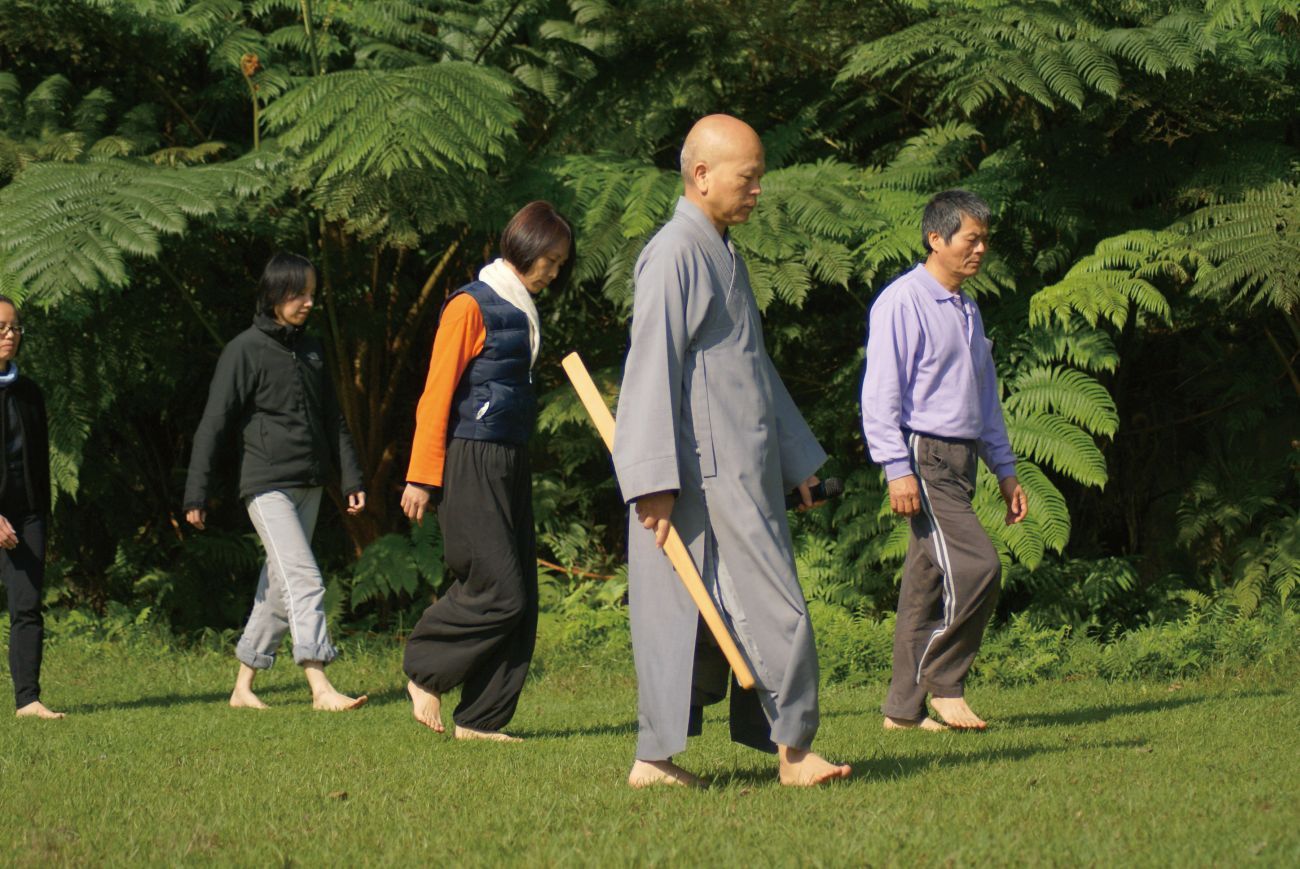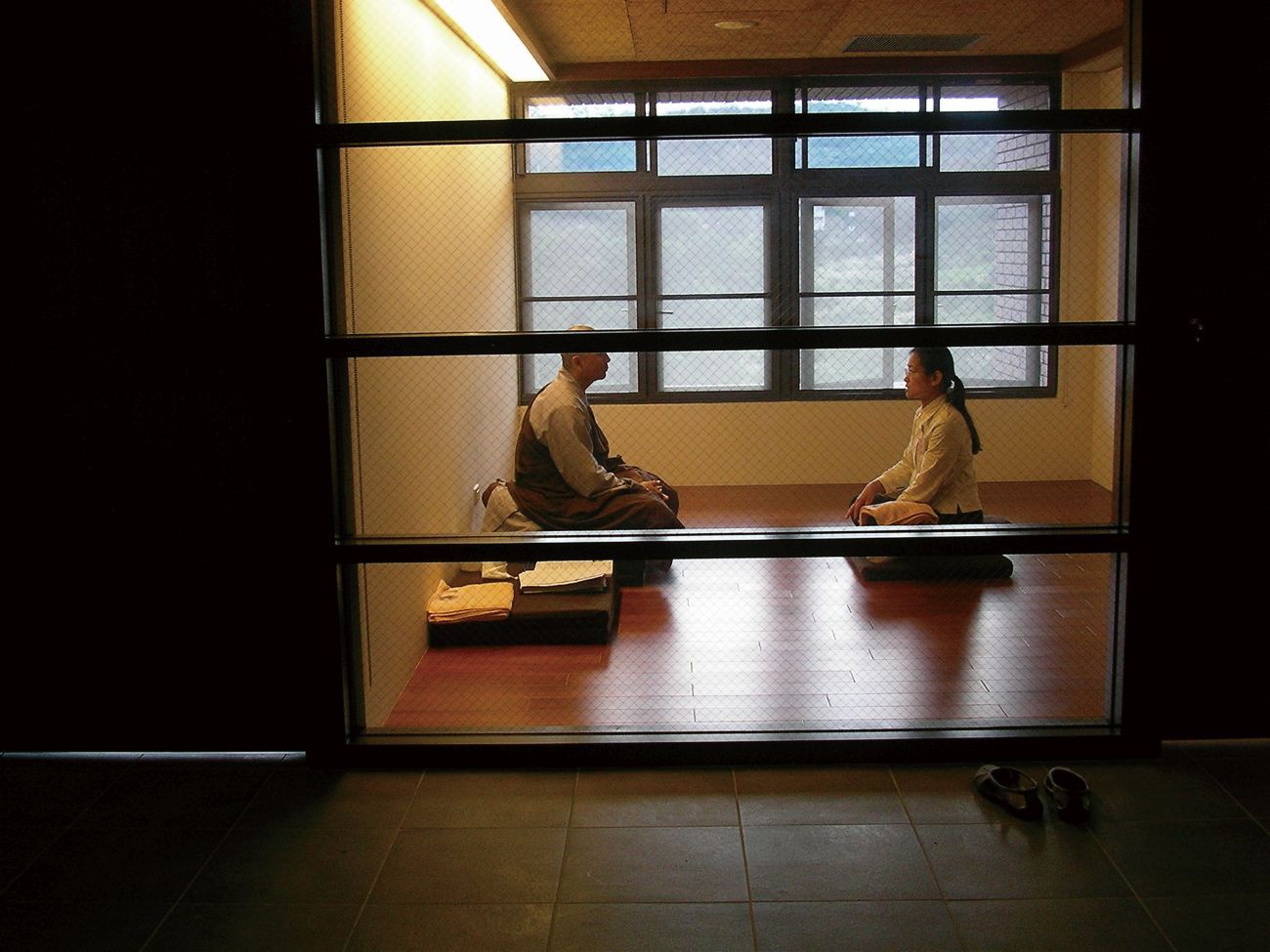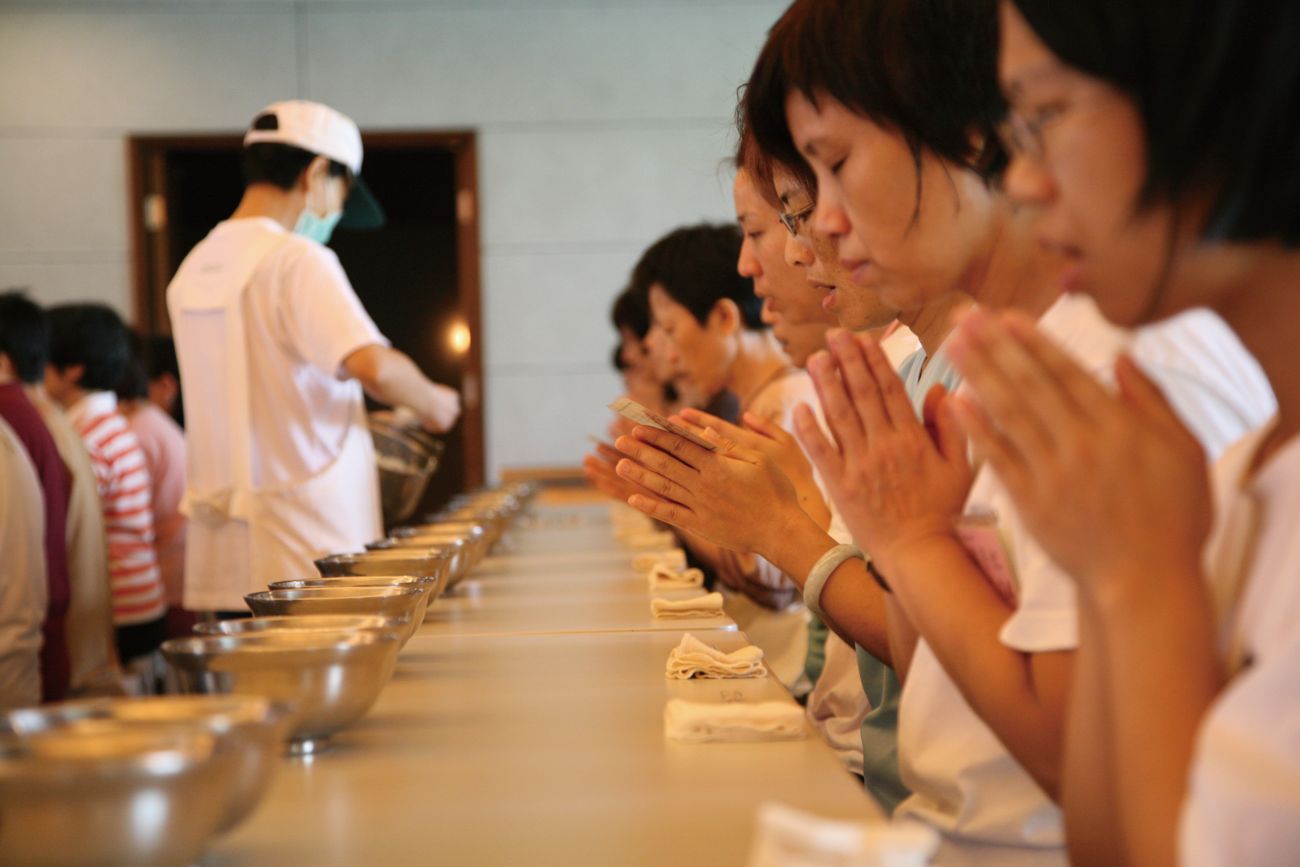Special Topics
What are the Regulations in the Meditation Hall?
Reasons Behind the Rules in the Meditation Hall:
While attending a seven-day Chan retreat in the meditation hall, we are expected to lead a vastly different lifestyle. What regulations are to be followed, and in what way can the rules facilitate our practice?
Ven. Guo Yuan (DDM Chan Hall master)
Cellphones and Valuable Belongings
Upon check-in, the organizer will collect participants' valuable personal belongings, such as cell phones and purses, to be kept away in a safe place. This is to help participants reduce outside contact during the retreat period as well as minimize any potential distractions. Participants will be reminded to set aside all business outside the meditation hall, put down thoughts of the past and the future, and continuously focus their mind on the method they are applying. Without their valuable personal belongings at hand, participants can better rein in their scattered minds.
 Practicing in Silence
Practicing in Silence
During the retreat, participants should practice in silence, without any need for greetings or establishing eye contact. This is done to avoid unnecessary chatting and fluctuating thoughts, so that we can face ourselves with a clearer mind instead. Maintaining silence helps participants to concentrate on their method of Chan practice and remain aware of their bodily and mental states, thus gaining a better understanding of themselves. Having a settled body and mind can enhance the benefits of applying the practice method and listening to the Dharma talk.
Listening to Dharma Talks
A seven-day Chan retreat organized by Dharma Drum Mountain includes sessions to listen to Master Sheng Yen's retreat Dharma talks. The retreat master or the guiding monastic will also deliver daily talks to the participants, to help them to establish proper concepts of Buddhist practice and understand how to apply the methods. During the talks, note-taking is not encouraged; participants only need to listen attentively to absorb the meaning.
 Private Interviews
Private Interviews
From the third day onward, there will be private interview sessions. Participants take turns going to the instruction room to report on their bodily and mental states to the monastics, or to ask questions about problems encountered during the practice. Private interviews enable participants to receive answers to their questions, as well as clarify uncertainties regarding their methods, concepts, and states of mind. Questions are limited exclusively to the conditions they encounter during the very retreat , without involving previous retreat experiences.
 Formal Buddhist Meal (Guotang)
Formal Buddhist Meal (Guotang)
Formal Buddhist meal is a special way of receiving food during the retreat. Breakfast and lunch are served in this way, while dinner (yaoshi) is served buffet-style. During formal meal times, each person will receive two bowls and a pair of chopsticks. The two bowls are to be placed at the edge of the table, while the volunteers place food into your bowls. While eating, you should maintain a good posture by sitting up straight, bringing the bowl to your mouth, and not leaning your elbows on the table.
Before starting to eat, participants will chant the "Meal Offering Chant" as a gratitude offeringto the Three Jewels. The chant reminds participants to eat with a mind of gratitude, repentance, joy, equanimity, and diligence. With this way of serving food, we don't pick and choose what to eat; , instead, we eat what is served to us without using a differentiating mind, to help us eliminate our self-centered tendencies. Sitting up straight also enhances our qi circulation and digestion, showing the spirit of our practice.
After finishing the meal, pour some hot water into the bowls, use a piece of vegetable leaf to wipe off the grease and food residue sticking to the bowls, and then drink the water. This act shows that we cherish our blessings, and demonstrates consideration for the dish-washing volunteers to make their work easier.
Work Practice
After breakfast and lunch, everyone is expected to engage in work practice, which is mandatory for group practice. Work practice in the meditation hall is mainly a cleaning job. It allows us to server the group, while increasing our merit as a way of benefiting self and others.
Morning and Evening Services
The retreat morning and evening services include chanting the Great Compassion Dharani, the Ten Great Vows of Samantabhadra Bodhisattva, Bodhisattva Samantabhadra's Verse for Admonition of The Assembly, Bestowing Food to the Hungry Ghosts, Four Great Vows, and the Three Refuges.. Arranging these services is intended togive praise to the Three Jewels, and the content of the chants helps our practice as well. For example, in the morning service, chanting the Four Great Vows and the Bodhisattva Samantabhadra's Verse for Admonition of the Assembly helps us arouse our bodhisattva mind to engage in great benevolent deeds. Conversely, Bestowing Food to the Hungry Ghosts during the evening service can call forth our compassion.
Regular schedule
Participants keep a regular schedule, with fixed times for getting up, moving meditation, morning and evening services, meditation practice, meals, and going to bed. Following this regular schedule keeps our lives simple. Once we are used to it, our mind can easily feel settled.
There is no need even to wear a watch. All we need to do is follow the instructions and signals. The wooden board is used to signal times to get up, complete the work practice, and retire in the evening, while a handbell is used to signal times to, congregate . Follow the signal, don’t worry about the time, and simply enjoy the experience by living in the moment.
How to Apply Right Effort in Chan Practice
Preliminary Requirement: Relaxation
Relaxation is the foundation for all methods of Chan practice. No matter which method we employ, we need to learn how to relax. Without relaxing correctly, we won't be able to apply any method properly. Not only do we need to relax our body, but we should also relax our mind. However, relaxation does not mean slackness. After we are relaxed, we have to apply effort, by slowly and steadilyusing our practice methods.
The Main Method—Applying the Methods
Methods for Chan practice include following the breath, counting the breath, calming and contemplation, Silent Illumination, and Huatou Chan. After relaxing our body and mind, we can then start practicing these methods. The essential mentality behind practicing these methods is to not have any anticipation, but simply keep using the methods without trying to chase after mysterious experiences. Gradually, our mind will settle, our wandering thoughts will lessen, and we will feel less troubled. Continue with the practice in diligence, and we will develop in wisdom. This is the purpose of Chan meditation practice.
Supplementary Methods—Prostrating to the Buddha, Walking Meditation, and Yoga Exercise
Besides meditation, there will also be other practice activities, including prostrating to the Buddha. There are three kinds of prostration being practiced during the retreat, namely: prostration in gratitude to the Three Jewels, repentance prostration, and formlessness prostration. Prostrating to the Buddha is a supplementary method designed to regulate and harmonize our body and mind; it is also a way to practice concentration while in motion. Walking meditation (slow pace, fast pace, natural pace), yoga exercise and the Eight-form Moving Meditation also have the same effects.
While attending a seven-day Chan retreat in the meditation hall, we are expected to lead a vastly different lifestyle. What regulations are to be followed, and in what way can the rules facilitate our practice?
Ven. Guo Yuan (DDM Chan Hall master)
Cellphones and Valuable Belongings
Upon check-in, the organizer will collect participants' valuable personal belongings, such as cell phones and purses, to be kept away in a safe place. This is to help participants reduce outside contact during the retreat period as well as minimize any potential distractions. Participants will be reminded to set aside all business outside the meditation hall, put down thoughts of the past and the future, and continuously focus their mind on the method they are applying. Without their valuable personal belongings at hand, participants can better rein in their scattered minds.
 Practicing in Silence
Practicing in SilenceDuring the retreat, participants should practice in silence, without any need for greetings or establishing eye contact. This is done to avoid unnecessary chatting and fluctuating thoughts, so that we can face ourselves with a clearer mind instead. Maintaining silence helps participants to concentrate on their method of Chan practice and remain aware of their bodily and mental states, thus gaining a better understanding of themselves. Having a settled body and mind can enhance the benefits of applying the practice method and listening to the Dharma talk.
Listening to Dharma Talks
A seven-day Chan retreat organized by Dharma Drum Mountain includes sessions to listen to Master Sheng Yen's retreat Dharma talks. The retreat master or the guiding monastic will also deliver daily talks to the participants, to help them to establish proper concepts of Buddhist practice and understand how to apply the methods. During the talks, note-taking is not encouraged; participants only need to listen attentively to absorb the meaning.
 Private Interviews
Private InterviewsFrom the third day onward, there will be private interview sessions. Participants take turns going to the instruction room to report on their bodily and mental states to the monastics, or to ask questions about problems encountered during the practice. Private interviews enable participants to receive answers to their questions, as well as clarify uncertainties regarding their methods, concepts, and states of mind. Questions are limited exclusively to the conditions they encounter during the very retreat , without involving previous retreat experiences.
 Formal Buddhist Meal (Guotang)
Formal Buddhist Meal (Guotang)Formal Buddhist meal is a special way of receiving food during the retreat. Breakfast and lunch are served in this way, while dinner (yaoshi) is served buffet-style. During formal meal times, each person will receive two bowls and a pair of chopsticks. The two bowls are to be placed at the edge of the table, while the volunteers place food into your bowls. While eating, you should maintain a good posture by sitting up straight, bringing the bowl to your mouth, and not leaning your elbows on the table.
Before starting to eat, participants will chant the "Meal Offering Chant" as a gratitude offeringto the Three Jewels. The chant reminds participants to eat with a mind of gratitude, repentance, joy, equanimity, and diligence. With this way of serving food, we don't pick and choose what to eat; , instead, we eat what is served to us without using a differentiating mind, to help us eliminate our self-centered tendencies. Sitting up straight also enhances our qi circulation and digestion, showing the spirit of our practice.
After finishing the meal, pour some hot water into the bowls, use a piece of vegetable leaf to wipe off the grease and food residue sticking to the bowls, and then drink the water. This act shows that we cherish our blessings, and demonstrates consideration for the dish-washing volunteers to make their work easier.
Work Practice
After breakfast and lunch, everyone is expected to engage in work practice, which is mandatory for group practice. Work practice in the meditation hall is mainly a cleaning job. It allows us to server the group, while increasing our merit as a way of benefiting self and others.
Morning and Evening Services
The retreat morning and evening services include chanting the Great Compassion Dharani, the Ten Great Vows of Samantabhadra Bodhisattva, Bodhisattva Samantabhadra's Verse for Admonition of The Assembly, Bestowing Food to the Hungry Ghosts, Four Great Vows, and the Three Refuges.. Arranging these services is intended togive praise to the Three Jewels, and the content of the chants helps our practice as well. For example, in the morning service, chanting the Four Great Vows and the Bodhisattva Samantabhadra's Verse for Admonition of the Assembly helps us arouse our bodhisattva mind to engage in great benevolent deeds. Conversely, Bestowing Food to the Hungry Ghosts during the evening service can call forth our compassion.
Regular schedule
Participants keep a regular schedule, with fixed times for getting up, moving meditation, morning and evening services, meditation practice, meals, and going to bed. Following this regular schedule keeps our lives simple. Once we are used to it, our mind can easily feel settled.
There is no need even to wear a watch. All we need to do is follow the instructions and signals. The wooden board is used to signal times to get up, complete the work practice, and retire in the evening, while a handbell is used to signal times to, congregate . Follow the signal, don’t worry about the time, and simply enjoy the experience by living in the moment.
How to Apply Right Effort in Chan Practice
Preliminary Requirement: Relaxation
Relaxation is the foundation for all methods of Chan practice. No matter which method we employ, we need to learn how to relax. Without relaxing correctly, we won't be able to apply any method properly. Not only do we need to relax our body, but we should also relax our mind. However, relaxation does not mean slackness. After we are relaxed, we have to apply effort, by slowly and steadilyusing our practice methods.
The Main Method—Applying the Methods
Methods for Chan practice include following the breath, counting the breath, calming and contemplation, Silent Illumination, and Huatou Chan. After relaxing our body and mind, we can then start practicing these methods. The essential mentality behind practicing these methods is to not have any anticipation, but simply keep using the methods without trying to chase after mysterious experiences. Gradually, our mind will settle, our wandering thoughts will lessen, and we will feel less troubled. Continue with the practice in diligence, and we will develop in wisdom. This is the purpose of Chan meditation practice.
Supplementary Methods—Prostrating to the Buddha, Walking Meditation, and Yoga Exercise
Besides meditation, there will also be other practice activities, including prostrating to the Buddha. There are three kinds of prostration being practiced during the retreat, namely: prostration in gratitude to the Three Jewels, repentance prostration, and formlessness prostration. Prostrating to the Buddha is a supplementary method designed to regulate and harmonize our body and mind; it is also a way to practice concentration while in motion. Walking meditation (slow pace, fast pace, natural pace), yoga exercise and the Eight-form Moving Meditation also have the same effects.
Extended Reading:
1. Q&A for Meditation Beginners
2. Five Basic Trainings for Meditation Practice
3. What are the Regulations in the Meditation Hall?
4. A Guide to Meditation Practice
5. Dharma Instruments Used in Meditation Retreats
Resource: Issue 370 of Life Magazine, Dharma Drum Publishing Corporation
Photos: 釋常護, 許朝益
Translation: Denise
Editing: Chia-cheng Chang (張家誠), Keith Brown
1. Q&A for Meditation Beginners
2. Five Basic Trainings for Meditation Practice
3. What are the Regulations in the Meditation Hall?
4. A Guide to Meditation Practice
5. Dharma Instruments Used in Meditation Retreats
Resource: Issue 370 of Life Magazine, Dharma Drum Publishing Corporation
Photos: 釋常護, 許朝益
Translation: Denise
Editing: Chia-cheng Chang (張家誠), Keith Brown
